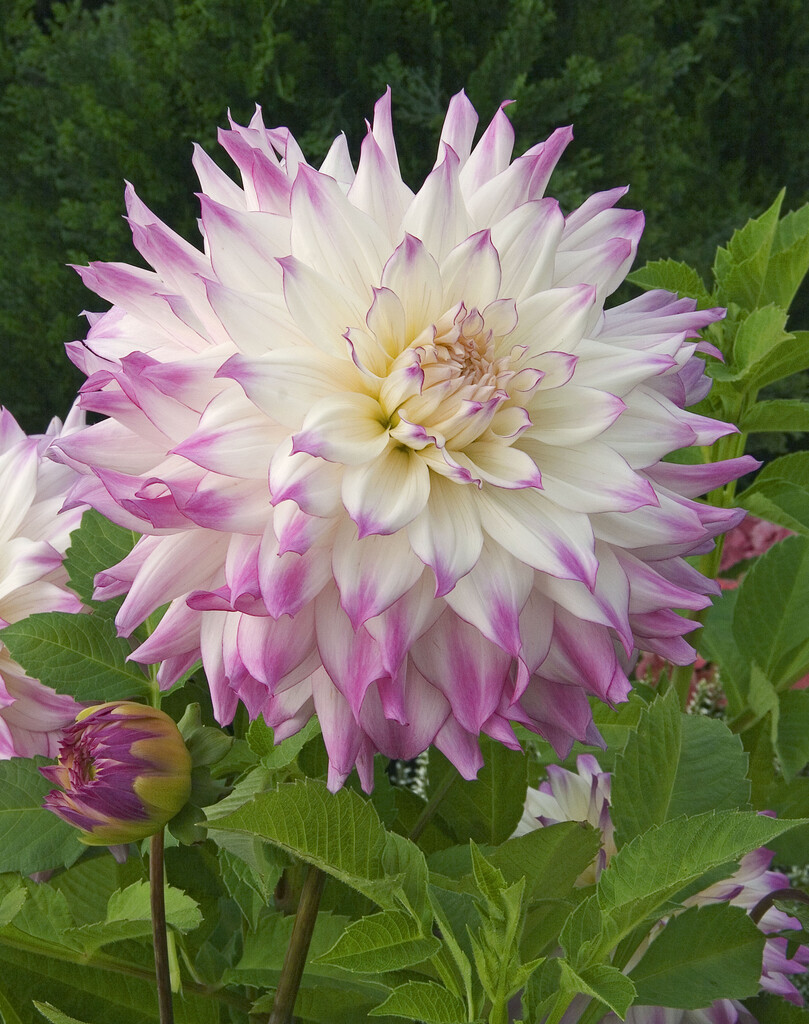Dahlia 'Ferncliff Illusion' (D)
dahlia 'Ferncliff Illusion'
Fls to 150mm wide; florets (upper surface) white (155C), overlaid with light reddish purple N78D towards apex, with some thin moderate purplish pink 186D veins on the bottom three-quarters of the florets; florets (lower surface) white (155C), overlaid with light reddish purple N78D towards apex, with pale greenish yellow 160C midvein and some thin moderate purplish pink 186D veins on the bottom three-quarters of the florets. Stem to 1.3m
Size
Ultimate height
1–1.5 metresTime to ultimate height
1 yearUltimate spread
0.5–1 metresGrowing conditions
Moisture
Moist but well–drainedpH
Acid, Alkaline, NeutralColour & scent
| Stem | Flower | Foliage | Fruit | |
| Spring | Green | |||
|---|---|---|---|---|
| Summer | Purple White | Green | ||
| Autumn | Purple White | Green | ||
| Winter |
Position
- Full sun
Aspect
South–facing or West–facing
Exposure
Sheltered Hardiness
H3Botanical details
- Family
- Asteraceae
- Native to GB / Ireland
- No
- Foliage
- Deciduous
- Habit
- Clump forming
- Genus
Dahlia are tuberous rooted perennials with pinnately divided leaves and showy flowerheads, double in many cultivars, in summer and autumn
- Name status
Accepted
- Horticultural Group
- Decorative dahlias have fully double flowerheads with flat or slightly incurved florets
How to grow
Cultivation
Grow in full sun, in fertile, humus-rich, well-drained soil enriched with organic matter and general-purpose fertiliser. Pinch out growing tips to encourage bushy plants, and stake. Water freely in dry periods. Lift and store tubers in autumn to replant, or use as a source of cuttings, in spring. See dahlia cultivation
Propagation
Propagate by softwood cuttings taken in spring from shoots from stored tubers, or divide the tubers, ensuring each section has at least one viable bud
Suggested planting locations and garden types
- City and courtyard gardens
- Cottage and informal garden
- Cut flowers
- Flower borders and beds
Pruning
Deadhead to prolong flowering. Cut back to near ground level in autumn, once frost has damaged foliage, before lifting and storing for the winter
Pests
May be susceptible to aphids, capsid bugs, caterpillars, earwigs nibbling flowers, glasshouse red spider mite and slugs
Diseases
May be susceptible to powdery mildews in dry conditions, fungal rots including grey mould in wet conditions and in storage, and a virus that causes stunting, leaf markings and distortion
Get involved
The Royal Horticultural Society is the UK’s leading gardening charity. We aim to enrich everyone’s life through plants, and make the UK a greener and more beautiful place.

